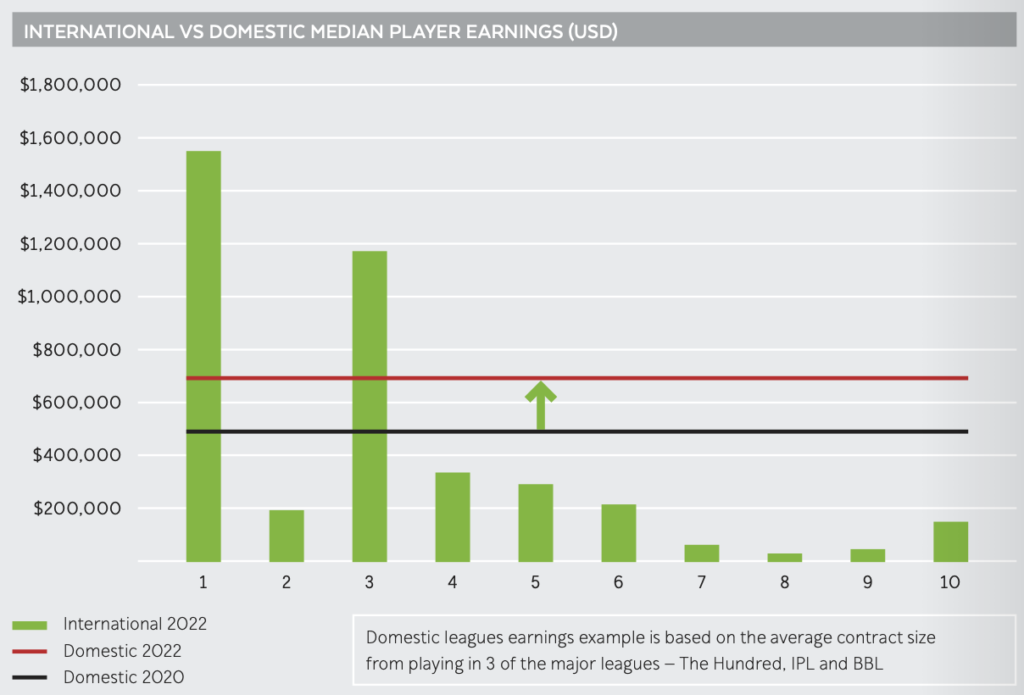To call it a dash for cash would be to disrespect the many who dedicate themselves to the uncertain and uneven marketplace that is the lot of professional cricketer, but a report has shown that more and more players are opting to make their money in the burgeoning wold of franchise cricket.
The increase in the number of domestic T20 leagues around the world is seeing a “growing trend” in the players moving towards the hybrid or free agent route instead of pursuing a career path through the traditional national contract route. In other words, playing for your country is no longer seen as a priority, but a path and an added extra in the career of professional players.
The Federation of International Cricketers’ Association’s (FICA) latest 2022 Men’s Global Employment Report shows that the “talent drain” they predicted four years ago in is full rage.
“Whilst historically the professional player employment pathway was a vertical one, working upwards in their own country towards international honours/ central contracts, increasingly, the horizontal employment pathway has expanded, with the opportunity to ply their trade playing in multiple domestic leagues as an overseas player, either in addition to, or instead of their home contract,” read the Fica report.
“This report period has seen the continuation of the trend of premature ‘flight of talent’ towards domestic leagues, which is driven by push and pull factors.”
The flight is driven by financial needs. That simple. That desperate.

“Most of the best players in the world continue to face a choice as to where they play due to the structure of the game. The trend of premature ‘flight of talent’ towards the ‘hybrid’ and ‘free agency’ markets, highlighted again in this report, has continued on the back of push and pull factors,” read the report.
- 49% would consider rejecting a central contract handed out to players who feature regularly in Test and limited-overs cricket, if they were paid more to play in domestic leagues
- Some 40% of the world’s top T20 players are “free agents”, with no connection to their homeland leagues.
- 42% are on a hybrid model, with national or domestic contracts – Think Quinton de Kock and his option to not play Test cricket for South African.
- 82% of players think a national contract is second best.
The growing trend towards hybrid employment (players playing both international and overseas domestic league cricket) and free agency (no national central contract) is becoming more prominent with premature flight of talent from international cricket still an issue on the back of game economics, and in the absence of a clear global structure for the game that includes the domestic leagues landscape.
“Professional cricket remains a short term and precarious career path with a number of players around the world facing issues of restraint, late or non-payment, bullying and harassment.”
Andrew Breetzke, CEO of the South African Cricketers Association(SACA) spoke to us on the advent of South Africa’s T20 League which launches in January and said, “it was inevitable that this would happen in South Africa and the challenge was what form it would happen and I think the way SA20 was structured is the ideal form. What is scaring people is the pace at which cricket is changing.”

The tournament follows the previous failed attempts to create the Global T20 League, and is South Africa’s answer to the proliferation of global T20 franchise leagues. Despite the potential and positives, the league will likely add further strain on the country’s window for bilateral international cricket, with international players being made available for it. It remains to be seen what effect the league will have on player retention in general, with many of South Africa’s most talented players historically opting to forge a career path abroad.
This is something to watch closely in the next year or two.
Related Posts
February 20, 2024
World Sports Betting To Sponsor Western Province Cricket Association
World Sports Betting has announced a renewed sponsorship agreement with the…
February 20, 2024
MultiChoice Renews Rights To LALIGA, EPL And Champions League
SuperSport, the leading African sports broadcaster, has made significant…
February 20, 2024
New World TV Secures UEFA Competition Rights For Frech-Speaking Sub-Saharan Africa
New World have secured exclusive rights to broadcast the UEFA Champions League,…



